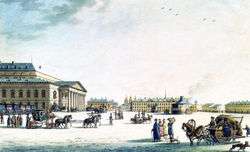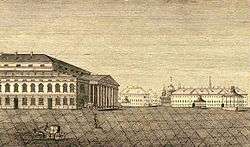Bolshoi Theatre, Saint Petersburg
The Saint Petersburg Imperial Bolshoi Kamenny Theatre (The Big Stone Theatre of Saint Petersburg, Russian: Большой Каменный Театр) was a theatre in Saint Petersburg.

by Benjamin Patersen.

It was built in 1783 to Antonio Rinaldi's Neoclassical design as the Kamenny (i.e., Stone) Theatre; Giovanni Paisiello’s opera Il mondo della luna was performed at the opening on 24 September.[1] It was rebuilt in 1802 according to the designs of the architect Thomas de Thomon and renamed the Bolshoi, but burned down in 1811.[1] The building was restored in 1818, and modified between 1826 and 1836 by Alberto Cavos to accommodate more modern machinery.[1]
Until 1886, the Bolshoi Kamenny Theatre was principal theatre for both the Imperial Ballet and the Imperial Russian Opera. It was there that the first Russian operas — Glinka's A Life for the Tsar and Ruslan and Lyudmila — were premiered. Although the theatre would include many of the great Russian operas in its repertory, many of the works of Tchaikovsky, Mussorgsky, and Rimsky-Korsakov received their world premieres on the stage of the Imperial Mariinsky Theatre. Many of the great 19th century ballets of Marius Petipa and Arthur Saint-Léon were given for the first time on the stage of the Bolshoi Kamenny Theatre.
In 1886 the building was declared unsafe and, at the behest of the theatre director Ivan Vsevolozhsky, the ballet and opera performances moved to the Imperial Mariinsky Theatre, where they have remained ever since. The Imperial Bolshoi Kamenny Theatre was then torn down to make way for the Saint Petersburg Conservatory. The only surviving sections of the original theatre are the grand staircase and landing, preserved in the building of the conservatory.
Notable premieres
Operas
- A Life for the Tsar (1836) – Mikhail Glinka
- Ruslan and Lyudmila (1842) – Mikhail Glinka
- La forza del destino (1862) – Giuseppe Verdi
Ballets
- The Pharaoh's Daughter (1862) – chor. Marius Petipa, mus. Cesare Pugni
- The Beauty of Lebanon or The Mountain Spirit chor. by Marius Petipa mus. Cesare Pugni.
- The Little Humpbacked Horse (1864) – chor. Arthur Saint-Léon, mus. Cesare Pugni
- La Bayadère (1877) – chor. Marius Petipa, mus. Ludwig Minkus
References
- "Mariinsky Theatre: History of the Theatre". Mariinsky Theatre. Retrieved 28 December 2016.
Benois, Alexandre: Reminiscences of the Russian Ballet (London, Wyman & Sons, 1941)